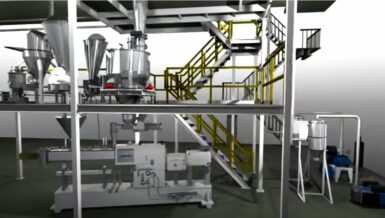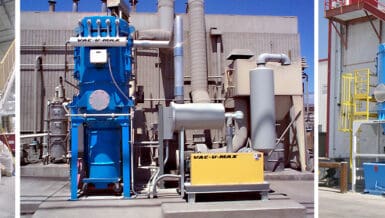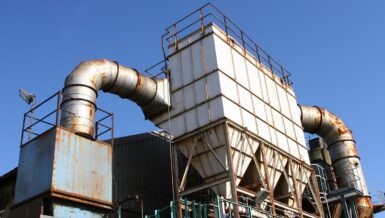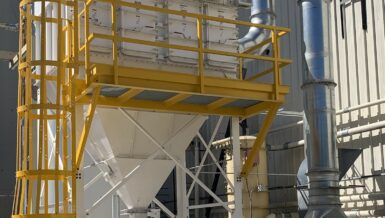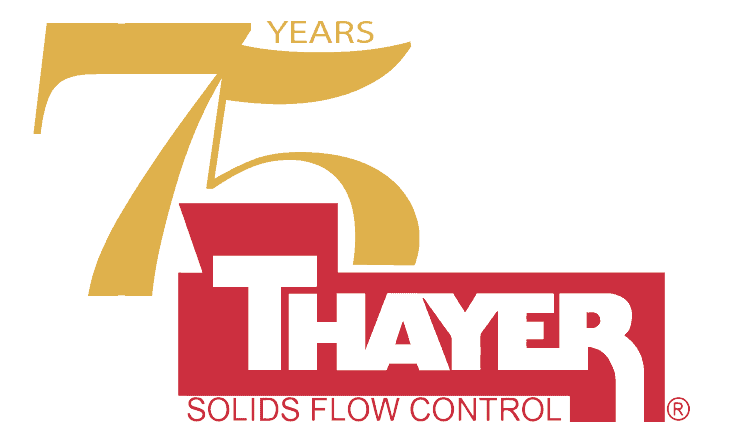In the new system, a screw conveyor horizontally transfers materials from nearby silos to the inlet hopper of an Olds Elevator. The Olds Elevator, which uses a new technology in which an outer tube rotates around a stationary screw, feeds the materials into the furnace. Due largely to the inherited dust-reducing features of the Olds Elevator, the production line experienced a dramatic reduction in airborne dust and the safety of the work environment was significantly improved for workers.
Introduction
To produce zinc oxide, a mixture of petroleum coke, sand, ultrafine zinc, and ashes are fed into a rotating furnace. A foundry in the north of the Iberian Peninsula faced serious dust problems in its 5 t/h production line, caused by air and materials leaking from belt conveyors.
The materials are toxic and therefore extremely dangerous to workers. Further, when mixed with air, the materials produce a potentially explosive dust. In some places of the facility, dust, and powder accumulated to a depth of 100 mm within 2 hours. As a consequence, one worker was engaged full-time in cleaning the area.

Existing Feeding System
The existing system comprised three belt conveyors, including a final, near-vertical conveyor to feed the furnace (Fig. 2).

installation of Olds Elevator
An Olds Elevator was installed to feed the furnace, replacing the final belt conveyor previously used (Fig. 3). The Olds Elevator’s inlet hopper is horizontally fed by a screw conveyor (Fig. 4). The joint between the Olds Elevator and the screw conveyor is hermetically sealed, as is the joint between the top of the intake hopper and the rotating casing (Fig. 5). Therefore, dust is prevented from escaping into the atmosphere.
Unlike a traditional screw auger, the Olds Elevator uses a stationary screw and a rotating outer tube. At the lower end of the tube, attached in-feed scoops draw material onto the screw flighting. Bulk material in the feed hopper covers the in-feed scoops. Inside the tube, friction against the inner wall of the casing rotates the material and causes the product resting on the screw flight to be driven gently up the inclined face of the screw. At the top, an outlet hopper collects the material and directs it into the furnace.
Several features of the Olds Elevator help reduce dust generation. There is generous annular clearance between the outside of the screw and the tube. This clearance is an important design feature that reduces casing wear and eliminates metal-on-metal contact. This also practically eliminates the grinding of material and the potential for sparking that can occur in conventional screw elevators.
Figure 4 – Olds Elevator intake. Figure 5 – Top of the Olds Elevator’s intake hopper showing seal.
Furthermore, the elevator tube is completely occupied with material during operation. Therefore, the volume of air that can mix with the product and subsequently become dust is minimized. In a production line, the flooded elevator tube also provides a barrier to the propagation of an explosion or fire that may originate in other parts of the plant. Compared to conventional screw conveyors, there is little back-flow of material because the annular clearance is occupied with material, and this improves “transport” (operational) efficiency. This also helps to stabilize the central position of the screw to prevent casing contact and contrasts dramatically with the dynamic “leakage” that takes place in a conventional screw elevator that offers little resistance to the whirling potential of the rotating screw. Transport efficiency is increased further by the lower slippage between the particles and screw flight surface.
Little dust is generated as the material exits the tube because the air between the particles is minimized during the gentle conveying process.
The in-feed scoops provide a positive, controlled input of material that is volumetrically proportional to casing speed. Hence, the machine can be used as a feed-rate controller. Furthermore, the elevator can be operated over a wide range of rotational speeds and hence, turn-down ratios. Also, the flow of material through and from the Olds Elevator is always smooth and steady, without the pulsations experienced with conventional screw conveyors and bucket elevators. This steady mode of flow is gentle to the product and, therefore, further minimizes particle damage and dust generation.
At all points, bearings are external to the product flow and accessible for maintenance, if required. With no seals or bearings at the discharge, the elevator is well suited to handling hot, abrasive, and corrosive materials.
Dust Mitigation Results
The new line has been working for a year and no problems have been reported. Airborne dust has been significantly reduced.
Conclusions
The new conveying system, incorporating a hermetically sealed screw conveyor and an Olds Elevator, dramatically reduced dust in a zinc oxide production line. The Olds Elevator employs a static screw and rotating casing and provides inherit dust-reduction features. In the plant, the health and safety of workers have been improved.











